How To Import Data Using Proc With Vertical Bar Delimited In Sas
In this article, we hash out 2 means to import a text file (.txt) into SAS.
We evidence how to import a text file with PROC IMPORT and a SAS DATA STEP. We support the methods with examples and SAS code.
Sample Data
Throughout the examples in this article, we import different .txt-files with data well-nigh a shoe company. This data is based on the SHOES dataset from the SASHELP library.
In a previous article, nosotros discussed how to export a SAS dataset as a text file. Now, we volition bear witness how to import i.
The SHOES dataset has 395 rows and seven columns. The image below shows the first 6 rows.

The next table shows the variable types, formats, and labels of the SHOES dataset. Nosotros desire to make sure that the variable types haven't changed after importing the text file.
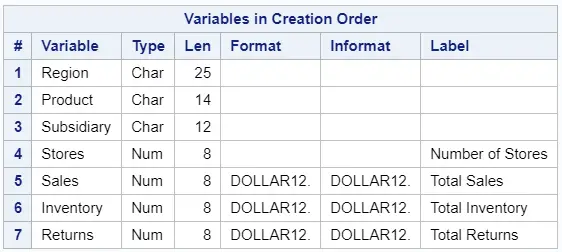
Import a Text File into SAS with PROC IMPORT
The offset method to import a text file into SAS is with the PROC IMPORT procedure. The PROC IMPORT process imports an external file and creates a SAS dataset. You can utilize PROC IMPORT to read unlike types of files, such as CSV, Excel, and Text.
How to Import a Text File with PROC IMPORT
In this section, we explain how to import a standard text file into SAS.
As an instance, we will import the "shoes.txt"-file. This file contains 396 rows, including a header on the first row, and 7 columns. The values of the columns are separated past a tab.

This is how yous import a text file into SAS with PROC IMPORT:
1. Ascertain the location, name, and extension of the file
The first required argument of the PROC IMPORT procedure is the FILE=-statement (or DATAFILE=-argument), This statement specifies the total path and filename of the text file.
2.Specify the name of the SAS output dataset
The 2nd required argument is the OUT=-argument. This argument specifies the name of the SAS dataset that the PROC IMPORT procedure creates.
3.Specify the type of data to import
The last required statement is the DBMS=-argument. This argument specifies the type of data PROC IMPORT is about to import. For text file (.txt) you use DBMS=tab.
The SAS code below shows how to combine these iii arguments to import the "shoes.txt"-file.
proc import file="/folders/myfolders/import/shoes.txt" out=work.shoes dbms=tab; run; While running the code to a higher place, SAS writes some notes to the log. The notes indicate whether the import was successful and how many rows were read from the input file.

We use the PROC Print procedure to show the kickoff 6 rows of thework.shoes dataset.
proc impress data=work.shoes (obs=6 ) noobs; run; 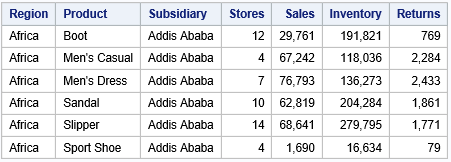
Finally, we use the PROC CONTENTS procedure to cheque the blazon of each column.
proc contents data=work.shoes order=varnum; run; 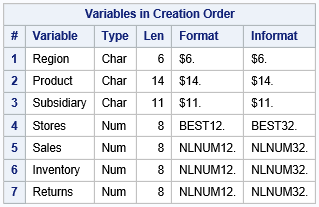
It seems that the PROC IMPORT procedure has identified correctly the type of each variable. However, theDOLLAR12.-format of the concluding three columns has been lost. As an alternative, you tin utilise a SAS Data Step to import a text file and explicitly specify the variable formats.
How to Overwrite an Existing Data Gear up
Past default, the PROC IMPORT procedure does not overwrite existing SAS datasets. This way, SAS prevents you from losing valuable information. Moreover, SAS writes a note to the log to notify y'all.
For instance, if you would run the SAS lawmaking below twice, SAS creates a special note the second time.
proc import file="/folders/myfolders/import/shoes.txt" out=work.shoes dbms=tab; run; 
Notwithstanding, on many occasions, y'all do want to overwrite an existing dataset. So,how practise you replace a dataset with PROC IMPORT?
You can overwrite an existing dataset with the Supersede selection. This option must exist placed subsequently the DBMS=-statement.
For example:
proc import file="/folders/myfolders/import/shoes.txt" out=work.shoes dbms=tab supervene upon; run; Import a Text File with Different Delimiters
When y'all import a text file and use the DBMS=tab argument, SAS assumes that the values of the columns are separated past a tab. However, there exist many other types of delimiters. For example, commas, semicolons, or pipes.
Y'all can specify the delimiter of a text file with the DELIMITER=-choice. The DELIMITER=-option is a new statement that must be placed after the REPLACE option. The character that is used every bit a delimiter must exist written between quotes.
In this department, we prove how to import text files with dissimilar delimiters.
How to Import a Comma Delimited Text File
A common character to split the values in a text file is the comma.

These are the steps to import a comma delimited text file into SAS
- Start the PROC IMPORT procedure with the PROC IMPORT keywords.
- Ascertain the location and filename of the text file with the FILE=-argument.
- Define the proper noun of the SAS output dataset with the OUT=-argument.
- Employ the DBMS=tab to import text files.
- Optionally, utilise the Supercede selection to overwrite an existing output dataset.
- Use the DELIMITER=","-argument to specify thatthe delimiter is a comma.
- End the PROC IMPORT prcodure with the RUN statement.
When you run the code below, SAS reads the comma-separated text file and creates a SAS dataset.
proc import file="/folders/myfolders/import/shoes_comma.txt" out=work.shoes dbms=tab supercede; delimiter=","; run; proc print data=work.shoes (obs=6 ) noobs; run; As the image below shows, the values of the last 3 columns are character instead of numeric. This is because the values in these columns were written between double quotes in the input file.
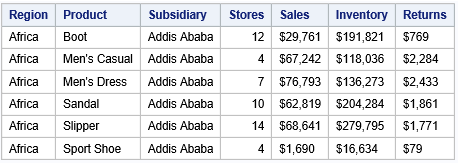
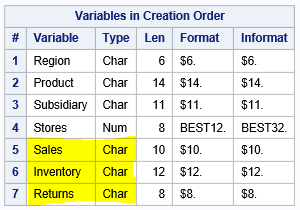
You tin modify the format of the final 3 columns with the INPUT statement, or apply a SAS Data Step to import the text file.
How to Import a Semicolon Delimited Text File
Another ofttimes used delimiter is the semicolon.
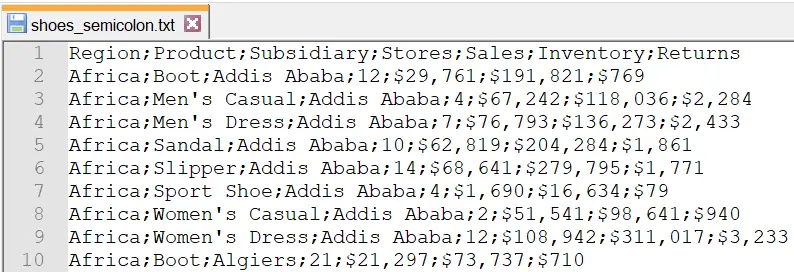
These are the steps to import a semicolon-delimited text file into SAS:
- First the PROC IMPORT process with the PROC IMPORT keywords.
- Ascertain the location and filename of the text file with the FILE=-argument.
- Define the proper name of the SAS output dataset with the OUT=-argument.
- Use the DBMS=tab to import text files.
- Optionally, employ the Supervene upon option to overwrite an existing output dataset.
- Apply the DELIMITER=";"-argument to specify thatthe delimiter is a semicolon.
- Finish the PROC IMPORT prcodure with the RUN argument.
proc import file="/folders/myfolders/import/shoes_semicolon.txt" out=piece of work.shoes dbms=tab supplant; delimiter=";"; run; proc print information=piece of work.shoes (obs=6 ) noobs; run; How to Import a Pipe Delimited Text File
A third delimiter is the pipe character (|). The image beneath shows an example of a pipage-delimited text file.
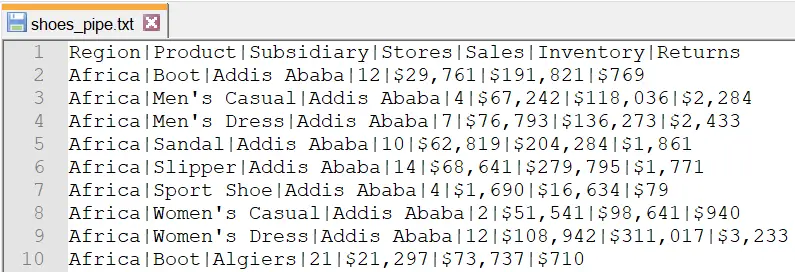
This is how to import a pipe-delimited text file into SAS with PROC IMPORT:
- Commencement the PROC IMPORT procedure with the PROC IMPORT keywords.
- Define the location and filename of the text file with the FILE=-argument.
- Define the name of the SAS output dataset with the OUT=-argument.
- Utilize the DBMS=tab to import text files.
- Optionally, use the REPLACE option to overwrite an existing output dataset.
- Apply the DELIMITER="|"-argument to specify thatthe delimiter is a pipage character.
- Stop the PROC IMPORT prcodure with the RUN argument.
The SAS lawmaking below contains an example of how to read a text file with the pipe grapheme every bit the delimiter.
proc import file="/folders/myfolders/import/shoes_pipe.txt" out=work.shoes dbms=tab replace; delimiter="|"; run; proc print data=work.shoes (obs=6 ) noobs; run; How to Import a Space Delimited Text File
The last character we discuss as a delimiter is a unmarried space/blank.
The SAS code to read text files with a bare as a delimiter is straightforward. Even so, earlier you start reading a infinite-delimited file, make sure that data values that contain spaces are written betwixt double-quotes. See the prototype below for some examples.

These are the vii steps to import a space/blank delimited text file into SAS:
- Start the PROC IMPORT process with the PROC IMPORT keywords.
- Ascertain the location and filename of the text file with the FILE=-argument.
- Define the name of the SAS output dataset with the OUT=-argument.
- Utilise the DBMS=tab to import text files.
- Optionally, use the Supplant option to overwrite an existing output dataset.
- Utilise the DELIMITER=" "-argument to specify thatthe delimiter is a signle space/blank.
- Finish the PROC IMPORT prcodure with the RUN statement.
proc import file="/folders/myfolders/import/shoes_space.txt" out=work.shoes dbms=tab replace; delimiter=" "; run; proc print data=piece of work.shoes (obs=six ) noobs; run; How to Import a Text File without Header
The PROC IMPORT procedure expects that the first row of a text file contains the header. Simply,how do you import a text file without a header into SAS?
For example, the text file below has no header and the information values start directly on the first row.

SAS assumes that the first row contains the column names if you would apply the standard lawmaking to read the file above. Since this is not the case, the outcome of the import is non every bit expected.
proc import file="/folders/myfolders/import/shoes_no_header.txt" out=work.shoes dbms=tab replace; run; proc print data=piece of work.shoes (obs=6 ) noobs; run; 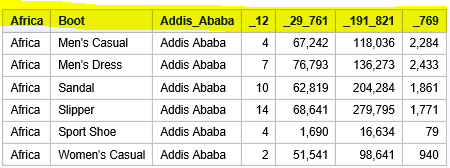
To import a text file without a header, yous need the GETNAMES=-selection. This option lets the PROC IMPORT procedure know that the text file has cavalcade names or not.
Past default, the value of the GETNAMES=-option is YES. However, if the input file doesn't have a header, you lot demand to use GETNAMES=NO.
The lawmaking beneath shows how to utilize the GETNAMES=-pick.
proc import file="/folders/myfolders/import/shoes_no_header.txt" out=work.shoes dbms=tab replace; getnames=no; run; proc print data=work.shoes (obs=vi ) noobs; run; Every bit y'all can encounter in the image below, the import was successful. If a text file does not contain a header, SAS calls the columnsVAR1,VAR2,VAR3, etc. If necessary, y'all can change the column names with the RENAME=-option in a subsequent Data Step.
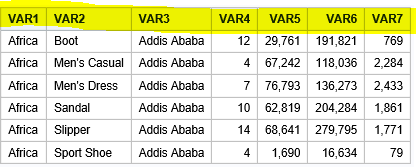
How to Import a Text File and Specify the First Row with Data
Normally, the first row of a file contains data. But,how do yous import a text file where the data starts at another row?
For example, in the text file beneath, the data starts at row 4.
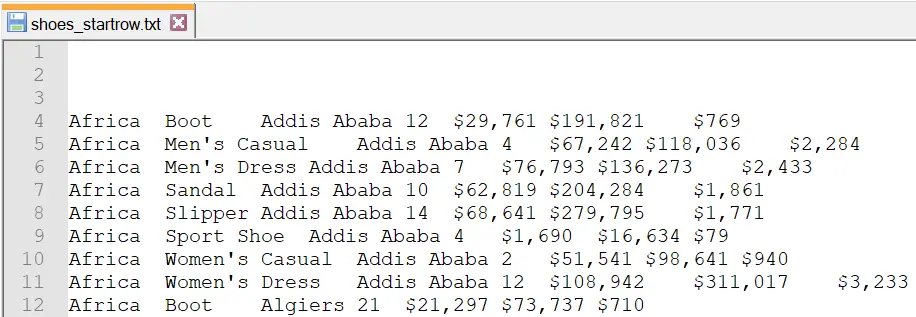
If you would run the standard SAS code to import the file higher up, SAS assumes that the first row contains the header and subsequent rows have data values. Still, since this is not the case, the result of the PROC IMPORT procedure is not equally expected.
proc import file="/folders/myfolders/import/shoes_startrow.txt" out=piece of work.shoes dbms=tab replace; run; proc impress information=work.shoes (obs=six ) noobs; run; 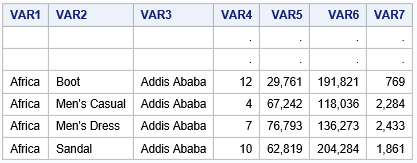
A solution to the problem above is to add an actress Data Footstep to filter out the blank rows and alter the column names. However, in that location is an easier style to import text files where the information doesn't offset at the first row.
You can utilize the DATAROW=-pick to start the import of a text file from a specified row. The DATAROW=-option is a separate statement of the PROC IMPORT procedure and must be placed after the REPLACE option. Acceptable values of the DATAROW=-option are all integers greater than or equal to 1.
The SAS code below shows how to read a text file where the data starts in the fourth row.
proc import file="/folders/myfolders/import/shoes_startrow.txt" out=work.shoes dbms=tab supersede; datarow=4; run; proc impress data=work.shoes (obs=6 ) noobs; run; 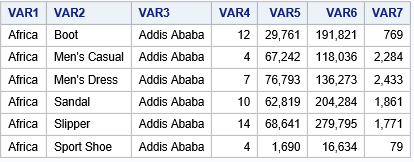
Note that, if you employ the DATAROW=-choice, the GETNAMES=-selection won't work. The GETNAMES=-option only works if the variable names are in the first row.
How to Import a Text File and Guess the Variable Types
The last option of the PROC IMPORT procedure we discuss is the GUESSINGROWS=-option.
Because PROC IMPORT doesn't let you specify the data type of the variables of a text file, it makes a guess based on the first twenty rows.
However, if the first twenty rows are empty or tin can be interpreted as both numeric and grapheme, then this gauge might exist incorrect.So, to increment the number of rows that SAS takes into account to guess the data type you tin use the GUESSINGROWS=-option. You can specify the number of rows or set it to MAX (2147483647 rows).
The example below shows how to use the first 100 rows to estimate the variable type of each column.
proc import file="/folders/myfolders/import/shoes.txt" out=piece of work.shoes dbms=tab supersede; guessingrows=100; run; proc impress information=work.shoes (obs=6 ) noobs; run; Import a Text File into SAS with a Data STEP
A second method to import a text file into SAS is with a SAS Information Step.
This method requires more lines of lawmaking compared to the PROC IMPORT procedure. All the same, the SAS DATA Step provides a lot more flexibility concerning defining variable types and variable formats.
How to Import a Text File with a DATA STEP
The paradigm below shows the starting time rows of the "shoes.txt"-file that we will import with a SAS DATA Footstep.
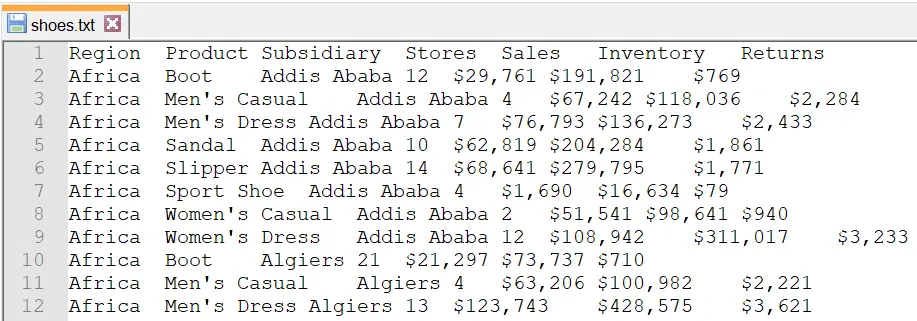
Here is how to import a text file into SAS with a SAS DATA Footstep:
1. Specify the output dataset
The first step in reading a text file with a DATA STEP into SAS is specifying the name of the dataset that will contain the imported data. You practise this with the DATA argument. For example,
DATA piece of work.shoes_import;
2. Define the file location, file name, and file extension of the text file
The second pace is to specify the total path and filename of the text file you want to import. You lot practice this with the INFILE statement. The path and filename must exist written between quotes.
infile "/folders/myfolders/import/shoes.txt"
iii. Specify the INFILE options
The INFILE statement has several options.
Thedelimiter pick specifies the symbol that separates the values in the text file. Ordinarily, this is a tab, but information technology can be some other grapheme. The delimiter must be enclosed in double-quotes. The delimiter for a tab-separated fil is "09"10.
Themissover option tells SAS to go along reading the text file when it encounters a missing value. That is to say when it encounters two sequent delimiters.
Thedsd option lets SAS know to ignore delimiters that are enclosed between double-quotes. For example (in the delimiter is a comma), "$xv,500".
Thefirstobs option specifies the first row with data. If you use the Information Stride to import a text file, SAS doesn't expect a header. Yet, if the file does take a header and the actual data starts on the second row, and then you must set the FIRSTOBS=-option to 2.
4. Ascertain the formats of the variables in the text file
The fourth step is to define the names and formats of the variables in the text file. You do this with the INFORMAT statement. The INFORMAT statement lets SAS know how to interpret the values (i.e., their type and format).
v. Define the formats of the variables in the output dataset
The concluding step is to define the names and formats of the variables in the output dataset. You lot practice this with the FORMAT statement. In general, the INFORMAT and FORMAT statements are like.
The example below shows how to import a tab-delimited text file with a SAS Data Step. Notation that to read a tab-delimited file, you must utilize DELIMITER="09"x.
information piece of work.shoes; infile "/folders/myfolders/import/shoes.txt" delimiter = "09" x missover dsd firstobs=two; informat Region $50.; informat Product $50.; informat Subsidiary $50.; informat Stores best12.; informat Sales dollar12.; informat Inventory dollar12.; informat Returns dollar12.; format Region $50.; format Product $l.; format Subsidiary $50.; format Stores best12.; format Sales dollar12.; format Inventory dollar12.; format Returns dollar12.; input Region $ Product $ Subsidiary $ Stores Sales Inventory Returns; run; proc print data=work.shoes (obs=half-dozen ) noobs; run; 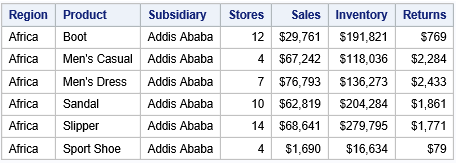
In contrast to PROC IMPORT, the SAS Information Stride automatically overwrites existing output datasets. So, it is not necessary to use the REPLACE option.
Equally mentioned earlier, using a SAS DATA Stride to import a text file requires many lines of code. To make life easier, you could utilise PROC IMPORT get-go, go to the log, copy the automatically generated code, and modify information technology as needed.
For example, this is the code generated past the PROC IMPORT procedure.
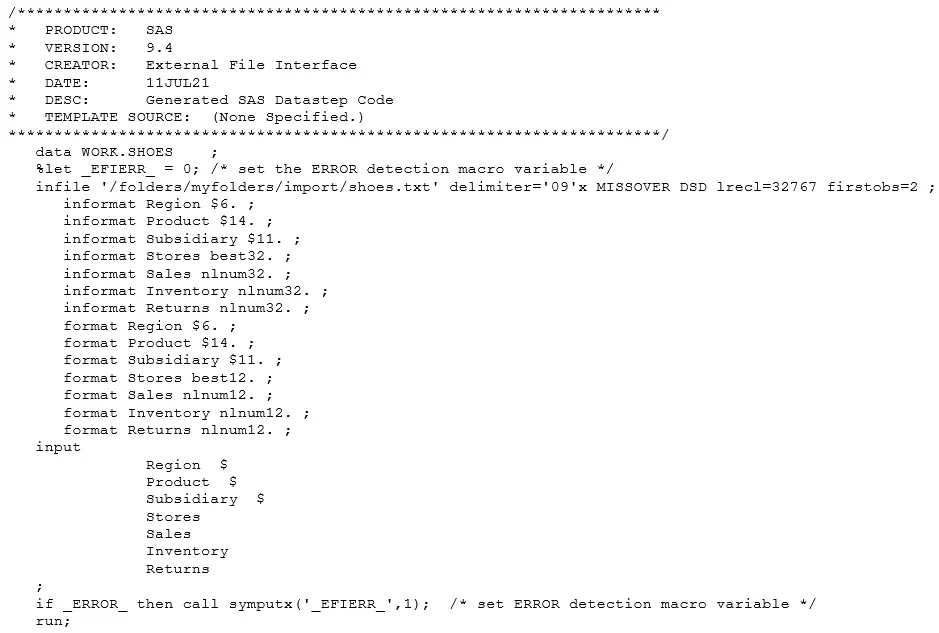
Import a Fixed Width Text File with Cavalcade Input
The information values in a text file can be separated by a special character, such equally a comma or a semicolon. But, how do you import text files with a fixed width between the columns?
The image below shows an example of a text file where the values of each variable start at a specific position (i.east., column).

Yous import a fixed-width text file into SAS with a Information Step. You use the Column Input method to specify the name, type, and cavalcade in which the value of each variable is located.
The Cavalcade Input method is a special type of INPUT statement. The argument starts with the INPUT keyword followed by the variable names, their types, and the position of the data values.
Note that, the Column Input method is also capable of reading fixed-width text files with missing values.
The SAS code below shows an example of how to read a text file where the information values start at a specific column.
data work.shoes; infile "/folders/myfolders/import/shoes_fixed_width.txt" delimiter = "09" x missover dsd firstobs=two; informat Region $50.; informat Product $50.; informat Subsidiary $l.; informat Stores best12.; informat Sales $fifty.; informat Inventory $fifty.; informat Returns $fifty.; format Region $l.; format Product $50.; format Subsidiary $50.; format Stores best12.; format Sales $fifty.; format Inventory $50.; format Returns $50.; input Region $ 1-29 Product $ thirty-49 Subsidiary $ 50-69 Stores 70-74 Sales $ 75-84 Inventory $ 85-94 Returns $; run; How To Import Data Using Proc With Vertical Bar Delimited In Sas,
Source: https://sasexamplecode.com/2-ways-to-import-a-text-file-into-sas-examples/
Posted by: joneswattelf.blogspot.com


0 Response to "How To Import Data Using Proc With Vertical Bar Delimited In Sas"
Post a Comment